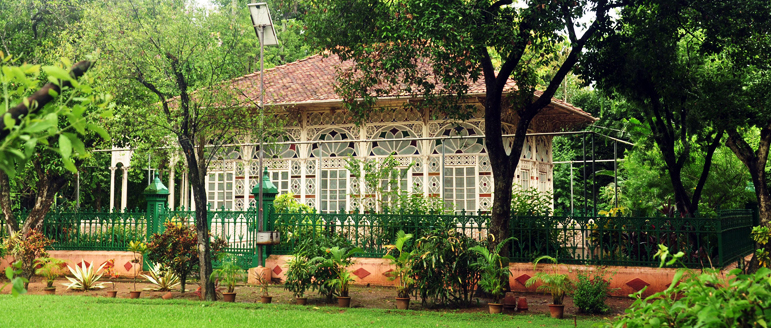Bandel Church was constructed in Bandel by the Portuguese after their settlement on the banks of Hooghly River. The first man to arrive from Portugal was Vasco da Gama in 1498. The Portuguese were of the barbaric nature and did business through might and force. Arrival of Portuguese in Bengal In 1535, Portuguese arrived in Bengal and started their trade from Saptagram which was situated on the banks of Saraswati River. In 1575, Mughal emperor Akbar allowed them to settle near Hooghly River. Meanwhile, river Saraswati dried up due to silting so the Portuguese started trading from their new settlement at Hooghly.

Priests of Portuguese also arrived in India and began to preach Christianity after getting permission from Akbar. This led to an increase in the followers of Christianity which further led to the construction of a church in Bandel in 1599 to commemorate the settlement of Portuguese in West Bengal. The church was named as Church of the Holy Rosary. Bandel Church is one of the oldest churches in India and declared as Basilica by Pope II in 1988. The church is dedicated to Mary, mother of Jesus Christ.
History of the Church: Portuguese became barbaric by the end of 16th century. They started robbing others and also sold women and children as slaves. When Mughal Emperor Shah Jahan came to know about this, he attacked the Hooghly port by sending an army under the command of Qasim Khan Juvayni Nawab. There were five priests out of which four were killed. Tiago tried to carry the statue of Mother Mary but could not succeed and the statue sank in the river. The church was also destroyed in the attack. The fifth priest Joan da Cruz was captured and was taken as prisoner along with his followers. Death sentence was given to them as punishment in which they had to be trampled below the feet of the elephants but one elephant raised the priest and put him on his back which amazed the emperor. So he freed the priest and the prisoners and sent them back to Hooghly. He also gave 311 acres of land to rebuild the church which was built in 1660.

Statue of Mother Mary: Statue of Mother Mary sank in the river. One day Father Joan da Cruz heard the voice of Tiago saying that Mother Mary is coming but he neglected it. Next day he found the statue on the bank of the river. The fishermen brought it back and put it on the bank. They celebrated the return of the statue of Mother Mary. Meanwhile, a Portuguese ship landed at the Bandel port and the captain said that they had faced a storm. The captain also said that he prayed to God that if they survive they will give the ship mast to the first church that they will see. As they had seen the Bandel church first, so they donated the ship mast to the church.

An "Imambara" or an "Imambargah" means (House of Imam or Court of Imam); this word is of North Indian origin. An Imambara is also known as Hussaniya, Ashoor Khana. An Imambara is a place or a building with a hall where people assemble for "Majlis" (Mourning Congregations) of Imam Husain and Martyrs of Karbala.
Hooghly Imambara: It's a massive two storeyed building which was built in the year 1861 by Mohammedan ruler Hazi Mohsin. This building is beautifully situated on the bank of river Ganga and is a major religious centre of the followers of Islam. Brilliantly carved walls, sculptured texts of the Holy Book of Quran, massive pillars on the entrance and an ancient clock tower are some of the most captivating features of this place. The northern block of this building houses a mosque and the southern block has been dedicated to the grave of its founder Hazi Mohsin. The Imambara is primarily known for its incredible maze, known as Bhul Bhulaiya locally, which is located on the upper floor of the monument.

Chinsurah – Hooghly – Colonial Memories ... The Dutch Cemetery: The Dutch may have built a settlement in Chinsurah long before the British settled in Sutanuti on the opposite bank of the Hooghly. Still, nothing is left of that settlement save a cemetery with about 191 graves, some with impressive masonry mausoleums. As in Serampore, where the extant Danish heritage is more substantial, these former colonisers are taking a renewed interest in what they left behind. The cemetery was built by Louis Taillefert, then director of the VOC in Bengal, the cemetery was active during the 18th–19th centuries, and houses many graves of Dutch citizens who died between 1743 and 1846. The oldest tomb belongs to Sir Cornelius Jonge who died in Chinsurah in 1743. Other prominent people buried here are Daniel Overbeck, Gregorius Herklots, a high official in the VOC, and George Vernet, another VOC director. The latter's tomb has no inscription.
The former French colony of Chandernagore is situated on the bank of the Hooghly River. Chandernagore was one of several competing European enclaves in this area. It was founded in 1673 and gradually expanded to become a great commercial centre. Chandannagar is known for its beautiful buildings, It was one of the most important French Settlements in Asia in the 18th century. Chandannagar was also the scene of fierce battles between the French and the British in their Quest for Control of India. Under the French Governor General Joseph Francois Dulexis(1697-1763), the City far surpassed its rival Calcutta, in terms of wealth and influence. But in the bitter fight for supremacy between the British and the French, the latter lost out in India and Chandannagar became a symbol of "what could have been" for the French in India.
Early morning departure from Kolkata to Kamarpukur distance of approximately 108 kilometres and typically takes around 3 hours. 30 minutes by road. On Arrival in Kamarpukur, the first stop is the Sri Ramakrishna Math, which welcomes visitors from 4:30 a.m. to 11:30 a.m. and again from 3:30 p.m. to 8:30 p.m.
Inside the Math, explore the temple premises, including the revered Shiva temple, now known as Yogi's Shiva Temple, frequented by Sri Ramakrishna during his spiritual practices.

The temple closes at 11:30 a.m. For Prasad (Bhog/ Rs. 30 per person) you have to arrive by 10 AM positively, to collect a ticket from the Office.
After that visit Joyrambati, a short 6-kilometer drive lasting approximately 15 to 20 minutes. Visit the Sri Matri Mandir in Joyrambati, situated on the sacred ground of Holy Mother Sarada Devi's birthplace.
The temple welcomes devotees from 5:30 am to 11:30 am, from 4:00 pm to 8:30 pm from April to September, and from 6:00 am to 11:30 am and 3:30 pm to 8:00 pm from October to March.
Return to Kamarpukur by 11.30 positively, Lunch starts at Noon in the Dining Hall of Kamarpukur Temple,. Lunch drive back to Kolkata, in the same way.
You may have Prasad from Joyrambati also, ticket distribution timings are the same.
For 4 per Sedan Car Rs. 6500
For 6 person Innova Car Rs. 7500
Bankura , Bishnupur & Mukutmanpur tour can be added with additional cost

Being a part of the cultural history, this place has Hazarduari Palace (The Palace of Thousand doors), built in the Italian style in 1837; Pearl Lake (Moti Jhil) just to the south, with Muradbagh Palace and Khushbagh Cemetry, containing the death tomb of Ali Vardi Khan, the last great Nawab, and grandfather of Siraj-al-Dawlah, who was himself was defeated by the British at the Battle of Plassey. This place has many colleges affiliated under University of Calcutta. This place has now became a tourist attraction for many national and foreign tourists because of its significant history and thriving handicraft industry. Murshidabad's surrounding region consists of the Rarh, a high, undulating continuation of the Chota-Nagpur plateau to the west, and the Bagri, a fertile, low-lying alluvial tract, part of the Ganga-Brahmaputra delta, to the east.

Hazarduari Palace: This place earlier famously known as Bara Kothi, located in the campus of Kila Nizamat in Murshidabad, in the state of West Bengal. Situated near the bank of river Ganga. The architect of this was Duncan Macleod, under the reign of Nawab Nazim Humayun Jah of Bengal, Bihar and Orissa (1824- 1838). Archaeological Survey of India took charge of this place in 1985. This place is listed under monuments of national importance in West Bengal. As the name suggests, this is a palace of thousand doors, the total sums up to 'the one with a thousand doors'. The place earlier was known as Bara Kothi has been named so as the palace has in all 1000 doors, of which 100 are false. The purpose of building such concepts was so that if a robber or a thief tried to steal something and escape, he would be confused between the original and artificial doors and meanwhile the guards got the time to catch him. This place now has a museum consisting of several miniature paintings and furniture, antiques and so on.
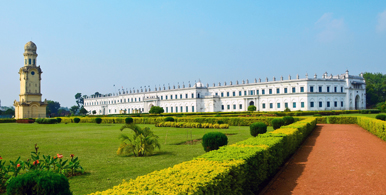
Nizamat Imambara: It's a place in Murshidabad dedicated for the worship of Shia Muslims. It was built in 1740 AD by Siraj ud Daula, the then Nawab of Bengal. This place was rebuilt in 1847 by Nawab Mansur Ali Khan after it was destroyed by fires. Known to be the largest Imam-Bara in the world.
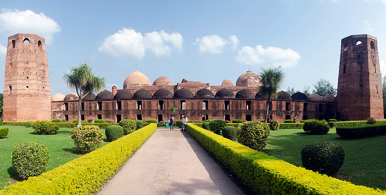
Katra Masjid: Formerly known as caravanserai, mosque and the tomb of Murshid- Quli Khan. It was being constructed between 1723 and 1724. One of the largest in the Indian subcontinent. It was built during the 18th century, when the early Bengal Subah was a major trade hub in Eurasia.
Katra Masjid is located in the north east side of the city of Murshidabad. The unique feature of the mosque are the two large corner towers having loopholes for musketry.
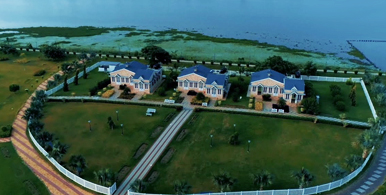
Motijheel: The Motijheel is the only tourist spot of Murshidabad catering to the tourism needs of all age groups. It is an attempt to preserve the famous historical tourist spot in Murshidabad for people of all age. It is a modern and contemporary spot, designed to satisfy the diverse tastes of tourists. It is a mixture of green eco- friendly environment along with its historical significance. People can enjoy boating, seesaws, swings and toy trains here.
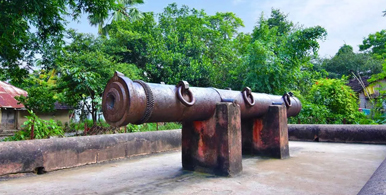
Jahan Kosha Cannon: Jahan josha literally means the destroyer of the world is a cannon placed in the Topekhana, which is 400m to the south east of the Katra Mosque, in the Murshidabad. Topekhana was the Nawab's own artillery park and entrance gate of old capital of Bengal subah consisting of Bengal, Bihar and Orissa. It is protected on the east by the Gobra Nala, famously known as Katra jheel. The canon is laid to rest here.
Jahan Kosha Cannon, Before being placed at the present location, it rested on a carriage with wheels and was surrounded by the roots of a Peepal tree. The gun is lifted 4feet above the ground by the roots of that Peepal tree. The wheel of the gun carriage have disappeared, but the iron-work of the carriage and the trunions are still visible. The canon is made up of silver, gold, lead, copper, zinc, tin, iron and mercury.
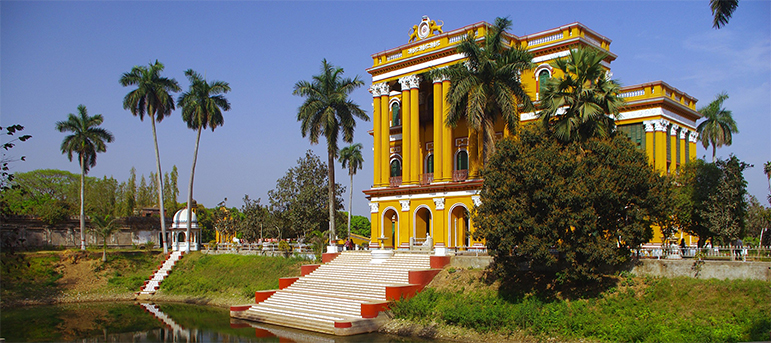
Kathgola Palace: It's a palace belongs to Durga family with historical significance at Murshidabad. Later on it converted into museum. Originally the name of this place was Kathgola Palace meaning wooden rose, but the name got distorted with time. In the 19th century Murshidabad was at its peak which attracted the Marwari and Jain community to come and trade in the area. This resulting their growth financially and construction of many Jain temples. Although, most of them shifted to Kolkata, with the ascendancy of the British, but even after that the buildings they built are still there. Kathgola palace and garden was built by Dhanpat Singh Dugar and Lakshmipat Singh Dugar in 1873. They hired a French architect to rebuild a part of this palace. A Bengali architect was also involved.

Fauti Masjid:Fauti mosque is a mosque at Kumarpur in Murshidabad in the Lalbagh sub-division. The mosque was constructed by Nawab Sarfaraz Khan in 1740 A.D. The old mosque is one of the largest in the Kumarpur and Murshidabad district. According to popular rumours, it is said that the mosque was built by nawab in a single night, but the masons were hired for several months where the mater role was called one day. But before the completion of the mosque, the nawab died in battle with Alivardi Khan and became faut and hence people renamed it as Fauti Mosque. The structure of this mosque is 135feet tall and 38feet broad with 5 domes and 4 spiral staircases at its four corners surmounted by cupolas. The domes are still not complete and that began to attract tourists more towards this mosque. The condition of this mosque today is completely ruined and filled with overgrown jungles due to lack of maintenance. It is a state protected monument.
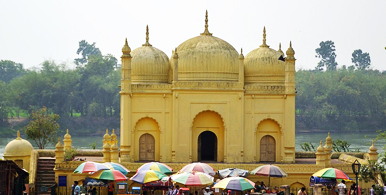
Yellow Mosque: This mosque is located inside hazarduari complex. Said to be built by Bengal nawab Siraj- Ud- Daula in between 1756-57, on the river bank of Bhagirathi. It is an ASI listed monument of national importance.
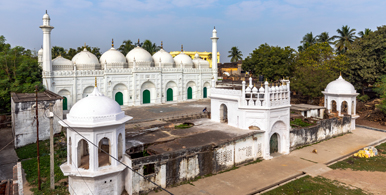
Chowk Masjid: Founded by Munny Begum, who was the wife of Mir Zafar. Earlier in this place a 40 pillared audience hall was constructed by Murshid Quli Khan. This mosque still recalls the stories of the ruling days of the Nawabs and still holds on its glorified past.
Chowk Masjid place was of great importance in the era of nawabs as Manny begum was a favourite of Robert Clive and Warren Hastings in terms of her lavish gifts which she use to receive from them.
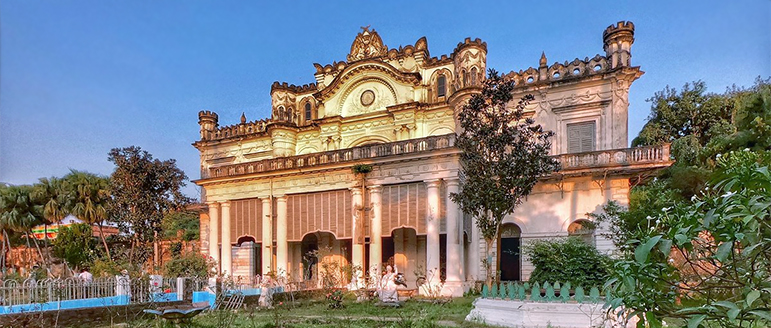
Wasif Manzil: It was constructed under by Nawab Wasif Ali Mirza Khan under the direction and supervision of Mr Vivian. This is a place used by Nawab as their own place of residence. Located close to Hazarduari Place. Built on the Nizamat Fort Campus between the campus's Dakshin Darwaza. The palace was destroyed by earthquake of 1897. The entire two floored building came down into one floored building within few minutes. This palace was constructed in such a way that it will look like a castle. The palace has a semi-circular pediment with the Nawabs of Murshidabad's coat of arms on it. ASI is now in charge of this building and converted into a museum. The garden space of this palace is filled with many marble statues along with a fountain. The entrance gateway has a wonderful work Norman archway with open-work iron doors. The marble statues inside of the place are worth watching.
